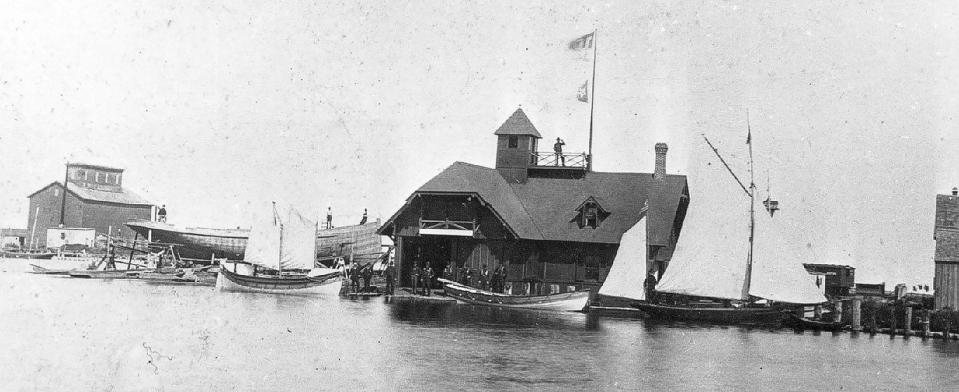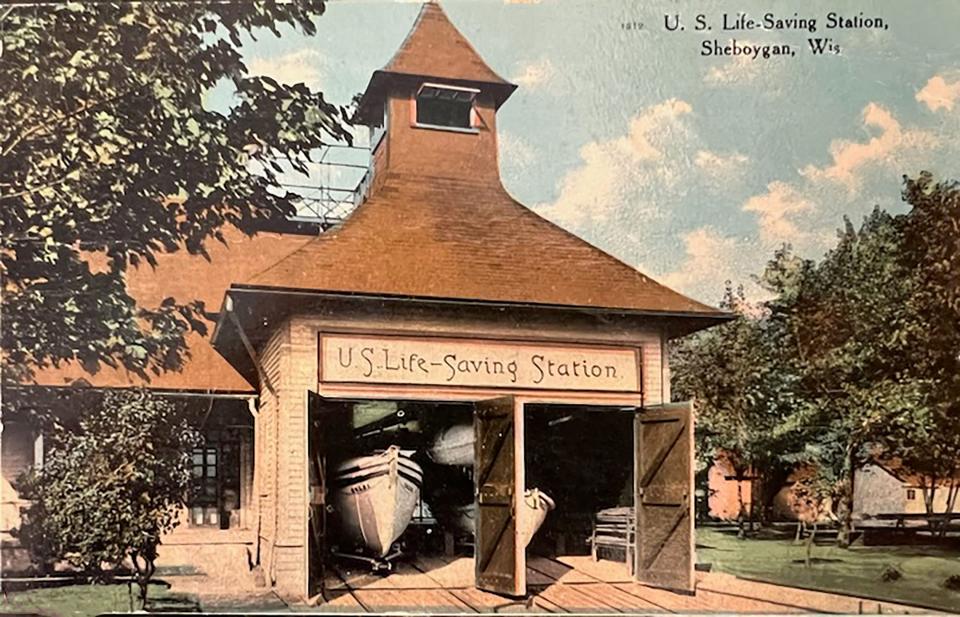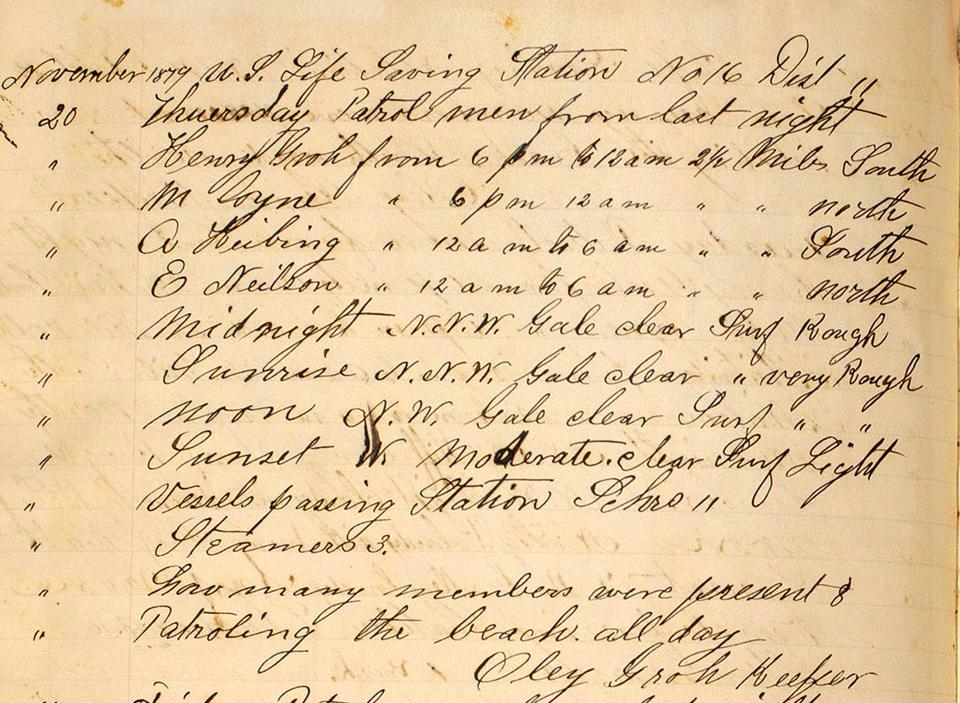Oley Groh was Sheboygan’s first Life Saving Station captain. He was known for saving lives and cargo amid fierce Lake Michigan storms.
SHEBOYGAN - As boat traffic became more prevalent on Lake Michigan, so did the need for people to be on hand to help when mayhem on the inland sea would arrive.
In 1874, Congress established the U.S. Life Saving Service, or USLSS. Life-saving stations at four harbors in Wisconsin were established. Sheboygan, Two Rivers, Milwaukee and Racine were the first four harbors designated to have these stations. Sheboygan's began operations in 1876, according to the Sheboygan County Historical Research Center book "Sheboygan, A City Defined by Water."
Oley Groh, an experienced seaman, commanded a crew of volunteers who were also experienced Great Lakes sailors. This group was called upon only when vessels in distress were spotted off Sheboygan or when stormy weather precipitated the likelihood of disaster. The life savers quickly earned a reputation for saving lives and cargo during fierce storms.
Groh was born to German immigrants in Galveston, Texas, on Jan. 11, 1846. His parents, Elizabeth and George, had immigrated to America a few months before his birth. His family left the Rhine area of Germany in 1844 because of political disturbances in that area.
The family remained in Galveston until the birth of Oley. They then moved to New Orleans, where they learned of the great movement of Germans, especially Rhinelanders, to Wisconsin.
Wisconsin was advertised as a new land full of promise, particularly well adapted for agriculture, according to a Sheboygan Press obituary for Groh that appeared Feb. 7, 1912.
So the family, full of ambition, went up the Mississippi, through its branches to Chicago. Then, via a sailing vessel up along the shore of Lake Michigan, arriving in 1848 in the same year Wisconsin became a state.
The young Oley would see public school only for a short while as his parents moved him to a German Lutheran school. His formal education was short because by the age of 10, economics were such he had to start earning his keep. The family lived close to the lake, and it was only natural that Groh would drift to seafaring occupations.
Groh first worked for local fishermen, leaving when became old enough to sail on the waters at age 16. He would go on an adventure of a lifetime, sailing on the Great Lakes and learning all the nuances of the inland seas. He would sail the lakes for the next 15 years.
In 1873, he ventured into commercial work in buying the tug Frank Geele in partnership with John Gas. He would command that boat until 1876, when he was appointed captain of the United States Life Saving Station that was being established in Sheboygan.

The first life savers were volunteers and went into action only when called upon to help.
However, a few years later, the life-saving station was re-established on a "paid basis" in 1880. At that time, Capt. Groh and his eight other local sailors became full-time paid employees of the U.S. government.
Oley's brothers, William and Henry, were two of the original members of the first paid life-saving crew in Sheboygan.
The first life-saving station was on the harbor entrance on the south side of the river. It stood on land that would later become part of the C. Reiss Coal Co. coal yards.
As there were no radio communications available at that time, the guardsmen would take daily walking trips on the shore along boat patrols around the harbor area.
In 1890, the life-saving station itself was moved to new quarters on the north side of the river, near where the current U.S. Coast Guard building is today.
In 1915, the USLSS and the U.S. Revenue-Marine Service, also known as the U.S. Revenue Cutter Service, merged to form today's U.S. Coast Guard.

Even though his tenure with the USLSS was a relatively short 10 years, he held a life-long fascination with the lake. During his time at the helm of life saving, he kept notes in a leather-bound notebook, written in flowing script, detailing ships that would come through the harbor.
The notebook was later used by Groh to paste marine-themed news clippings with some of the original notations still visible in the book. That book is part the Tryg Jacoboson collection. The scrapbook also included a collection of political cartoons and commentary pasted in by Groh.

For example, on Thursday Nov. 20, 1879, Groh wrote the following weather notes in his book:
Midnight: NNW winds. Gale clear, surf rough
Sunrise: NNW winds. Gale clear, surf very rough
Noon: NW winds. Gale clear surf very rough
Sunset: W winds moderate clear, surf light
Vessels passing station: Schooners 11, Steamers 3
Other: Patrolling the beach all day.
After he resigned from the Life Saving Station, he continued to have a deep interest in helping others in distress.
On the night of April 8, 1895 a severe storm swept the west shore of Lake Michigan. The following day, the schooner Lottie Cooper was seen off of Sheboygan, helpless in a gale of wind, according to a Press clipping from the Sheboygan County Historical Research Center. A signal of distress was flying from her mast. The sea was too high for a lifeboat. Captain Groh volunteered his services and the use of his tug.
With lifesavers on board the tug steamed out to the vessel which was at anchor about a half mile east of the harbor. Before the Lottie Cooper could be reached, she capsized and one of the crew drowned. The other six, clinging to the rigging were rescued, according to the clipping. The Press added, "To Captain Groh more than any other, do these men owe their lives."
After Groh's passing on February 7, 1912, the next day the Press ran almost two pages of copy outlining the heroics of the first head of Sheboygan's Life Saving Station. He is buried at Wildwood Cemetery.
Since then, over 20 individuals have been put in charge of the Life Saving Station and later the U.S. Coast Guard in Sheboygan. As technology improved, changes were made at the the second life-saving station, and parts of it, remained in use until 2007 when it was torn down to make way for the modern facility you see today.
To see the image larger, click here.
RELATED - Sheboygan’s fish shanties, today home to businesses, reflect bravery of early fishermen: Throwback
RELATED - Sheboygan museum is home to this 1860s log cabin built by German immigrants: Throwback
RELATED - Sheboygan's South Pier, today home to Blue Harbor Resort, was once an industrial hub | Throwback
This article originally appeared on Sheboygan Press: Sheboygan US Coast Guard station dates to 1876, US Life Saving Service

